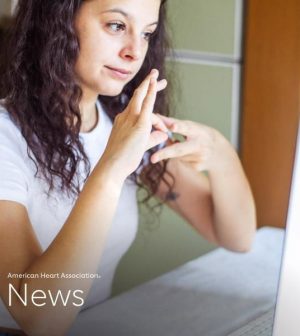- Navigating Your Midlife Crisis: Embracing New Possibilities
- City Raccoons Showing Signs of Domestication
- Mapping the Exposome: Science Broadens Focus to Environmental Disease Triggers
- One Week Less on Social Media Linked to Better Mental Health
- Your Brain Changes in Stages as You Age, Study Finds
- Some Suicide Victims Show No Typical Warning Signs, Study Finds
- ByHeart Formula Faces Lawsuits After Babies Sickened With Botulism
- Switch to Vegan Diet Could Cut Your Greenhouse Gas Emissions in Half
- Regular Bedtime Does Wonders for Blood Pressure
- Dining Alone Could Mean Worse Nutrition for Seniors
AHA News: How Technology Is Improving Health Information Access for the Deaf Community

MONDAY, July 12, 2021 (American Heart Association News) — Early in Dr. Michael McKee’s career, one of his patients, who was deaf, died from a heart attack. It led him to study how to prevent it from happening to others.
That tragic event might not have happened, he said, if there had been “accessible community health education programs to allow for deaf individuals to learn ways to improve their health and to recognize common danger signs of serious health conditions.”
So, in 2008, he led a small study to pinpoint how to best improve cardiovascular disease education in the deaf community. Published a few years later in Disability and Health Journal, the research found significant gaps in knowledge about cardiovascular health, from a lack of awareness about stroke to confusion about medications.
“Unfortunately, little (research) has focused on deaf individuals, notably signers,” said McKee, a family medicine physician at the Deaf Health Clinic at the University of Michigan’s Dexter Health Center.
Because of communication and language barriers, experts say research continues to be scant about cardiovascular health knowledge in the deaf community. And health professionals lack cultural awareness or familiarity with the unique needs of this underserved community.
But technology has been a great equalizer.
Dr. Gary Kaufman, medical director of Sinai Chicago’s Deaf Health and Sinai Medical Group’s Antillas Health Center, said the internet has “dramatically improved the interface between deaf individuals and the health system.” They’re able to access text and American Sign Language, or ASL, videos for valuable health information.
For example, researchers at the University of Michigan are working on a music video in which members of the deaf community perform a song about how to recognize the classic signs of a stroke – face drooping, arm weakness and speech difficulty. The initial work appeared last fall in the Journal of the American Heart Association.
Video calls on smartphones have enabled people to access an ASL interpreter. It’s a big improvement over a telecommunications device for the deaf, or TDD. That device looked like a typewriter with a small readout for communicating over the phone, which proved tedious because of the lagging responses from both parties. McKee said it also forced people who are deaf to communicate in writing, which some may struggle with, rather than in sign language.
Kaufman, who also has researched cardiovascular disease knowledge in the deaf community, said people who are deaf can fall victim to misinformation that’s further spread by “less access to casual relations,” meaning the deaf community doesn’t have easy access to medical information either actively by talking or passively by overhearing a conversation.
In other words, someone who can hear has easy access to information via TV, the internet and family and friends. Someone who is deaf, on the other hand, is limited to their insular social group.
This can be “analogous to an echo chamber,” Kaufman said.
That results in lower health literacy, McKee said, which is a major barrier to good heart health. He led a 2015 study published in the Journal of Health Communication that found people who are deaf are seven times more likely to have inadequate health literacy compared to people who can hear.
Improving the deaf community’s access to heart and brain health information should start at the doctor’s office, Kaufman said. That starts with making health platforms accessible to the deaf community. And health care professionals can help close the knowledge gaps by becoming more comfortable with, and taking advantage of, technology.
For example, doctors’ offices could offer patients who are deaf an online or text option to book appointments, request prescription refills or get test results, according to tips published by researchers in the British Journal of General Practice. During appointments, doctors should ensure interpreter services to ASL users as required by the Americans with Disabilities Act; use visual props and drawings; and face the patient when speaking. Health care providers also could benefit from deaf culture sensitivity training.
“Clinicians who embrace technology realize they will be more efficient and accurate in managing the patient’s needs by using technology tools,” Kaufman said.
Free community health programs for the deaf community can help bridge the remaining gaps, McKee said. For example, his university hosts Deaf Health Talks, a monthly livestream series conducted in ASL. And the nonprofit Association of Medical Professionals with Hearing Losses has a COVID-19 resource page specifically for the deaf community.
Additionally, he said, health care information should be geared not just to hearing people but also to the deaf community.
“There are precious few health information videos in sign language,” McKee said. “There needs to be better support from our health care systems and government to provide funding and effort to create these resources.”
American Heart Association News covers heart and brain health. Not all views expressed in this story reflect the official position of the American Heart Association. Copyright is owned or held by the American Heart Association, Inc., and all rights are reserved. If you have questions or comments about this story, please email editor@heart.org.
By Juana Poareo
Copyright © 2025 HealthDay. All rights reserved.










